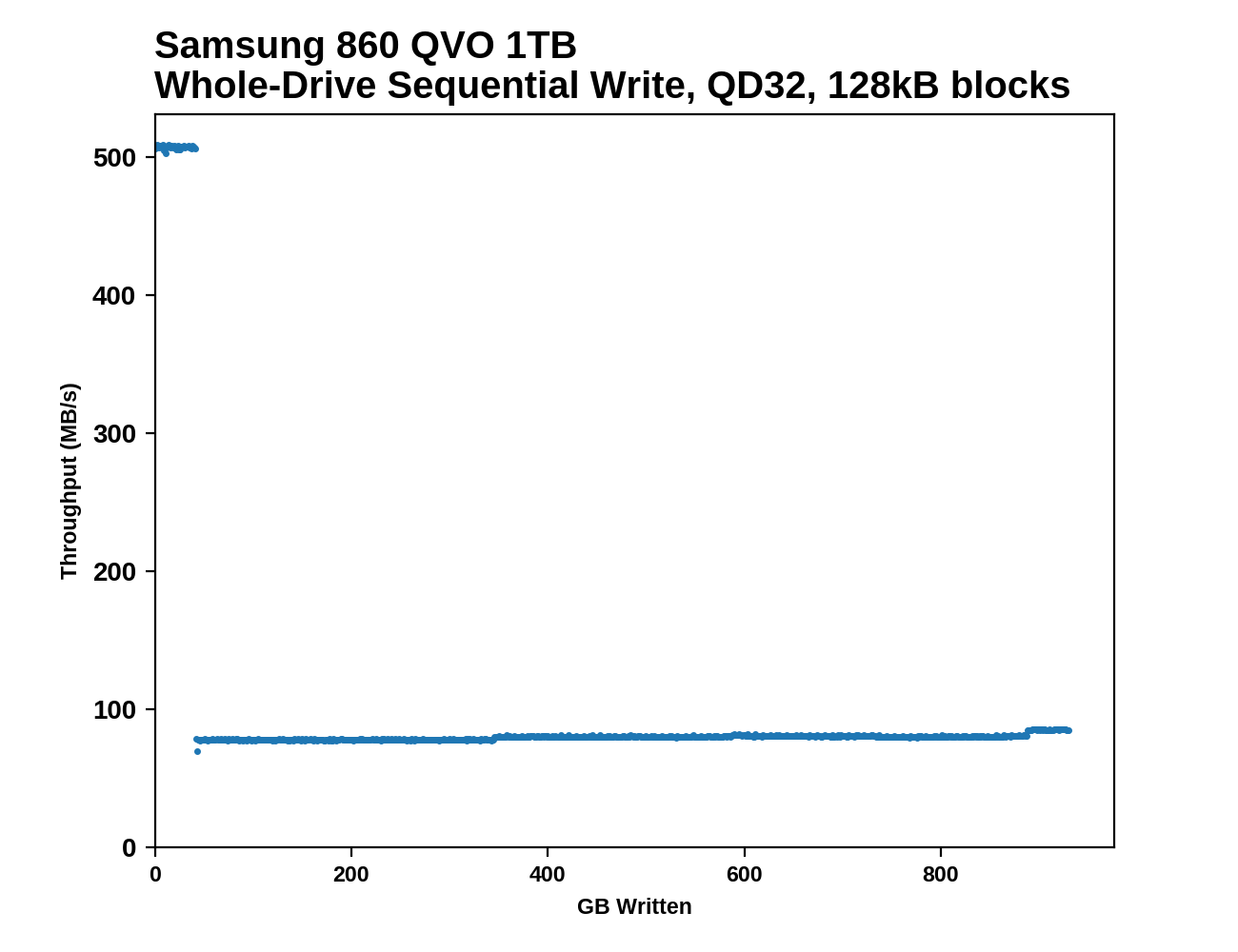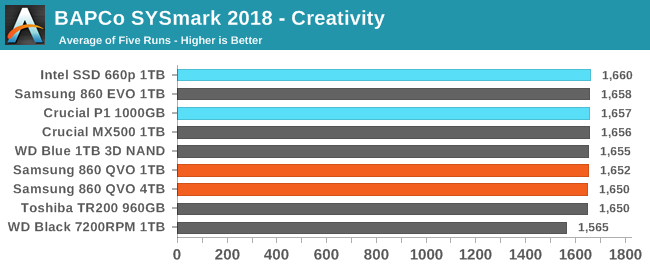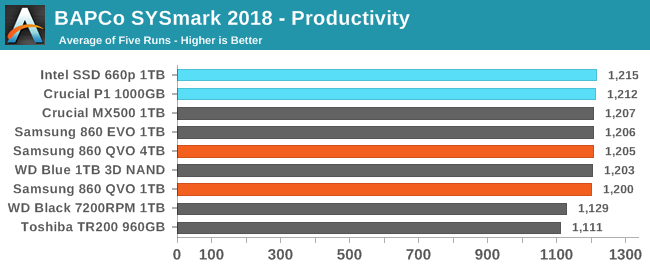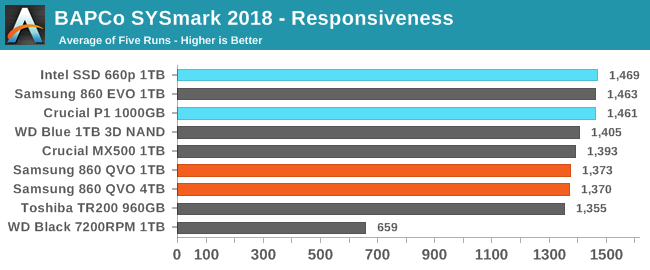The Samsung 860 QVO (1TB, 4TB) SSD Review: First Consumer SATA QLC
by Billy Tallis on November 27, 2018 11:20 AM ESTWhole-Drive Fill: Testing SLC Cache Size
This test starts with a freshly-erased drive and fills it with 128kB sequential writes at queue depth 32, recording the write speed for each 1GB segment. This test is not representative of any ordinary client/consumer usage pattern, but it does allow us to observe transitions in the drive's behavior as it fills up. This can allow us to estimate the size of any SLC write cache, and get a sense for how much performance remains on the rare occasions where real-world usage keeps writing data after filling the cache. Samsung's official specifications are:
| Samsung 860 QVO Secondary Specifications | |||||
| Capacity | 1 TB | 2 TB | 4 TB | ||
| SLC Cache Size |
Min | 6 GB | 6 GB | 6 GB | |
| Max | 42 GB | 78 GB | 78 GB | ||
| Sequential Write |
SLC Cache | 520 MB/s | |||
| QLC | 80 MB/s | 160 MB/s | 160 MB/s | ||
Our results show the following:
 |
|||||||||
The Samsung 860 QVOs run out of SLC cache right on schedule, at 42 GB for the 1TB model and 78 GB for the 4TB. After that, they are both slow and very steady for the rest of the test.
 |
|||||||||
| Average Throughput for last 16 GB | Overall Average Throughput | ||||||||
The 1TB 860 QVO falls below the sequential write speed of a 1TB hard drive once the SLC cache runs out, but the 4TB model is able to sustain twice the write speed and remains ahead of not just the hard drive's speed, but also some of the slower TLC drives.
BAPCo SYSmark 2018
BAPCo's SYSmark 2018 is an application-based benchmark that uses real-world applications to replay usage patterns of business users, with subscores for productivity, creativity and responsiveness. Scores represnt overall system performance and are calibrated against a reference system that is defined to score 1000 in each of the scenarios. A score of, say, 2000, would imply that the system under test is twice as fast as the reference system.
SYSmark scores are based on total application response time as seen by the user, including not only storage latency but time spent by the processor. This means there's a limit to how much a storage improvement could possibly increase scores, because the SSD is only in use for a small fraction of the total test duration. This is a significant difference from our ATSB tests where only the storage portion of the workload is replicated and disk idle times are cut short to a maximum of 25ms.
| AnandTech SYSmark SSD Testbed | |
| CPU | Intel Core i5-7400 |
| Motherboard | ASUS PRIME Z270-A |
| Chipset | Intel Z270 |
| Memory | 2x 8GB Corsair Vengeance DDR4-2400 CL17 |
| Case | In Win C583 |
| Power Supply | Cooler Master G550M |
| OS | Windows 10 64-bit, version 1803 |
Our SSD testing with SYSmark uses a different test system than the rest of our SSD tests. This machine is set up to measure total system power consumption rather than just the drive's power.



The 860 QVO isn't any slower for compute-heavy interactive tasks than the mainstream SATA SSDs, and even on the more I/O-bound Responsiveness test the 860 QVO is ahead of the DRAMless TLC drive and not far behind the Crucial MX500.
Energy Use
The SYSmark energy usage scores measure total system power consumption, excluding the display. Our SYSmark test system idles at around 26 W and peaks at over 60 W measured at the wall during the benchmark run. SATA SSDs seldom exceed 5 W and idle at a fraction of a watt, and the SSDs spend most of the test idle. This means the energy usage scores will inevitably be very close. A typical notebook system will tend to be better optimized for power efficiency than this desktop system, so the SSD would account for a much larger portion of the total and the score difference between SSDs would be more noticeable.

The Samsung 860 QVO's energy usage during SYSmark is not a problem at all, with it using slightly less energy than the mainstream SATA TLC drives.










109 Comments
View All Comments
boozed - Sunday, March 24, 2019 - link
RecoupedFunBunny2 - Tuesday, November 27, 2018 - link
"moving off of spinning rust and onto SSDs with my bulk storage. "well... cold storage of NAND ain't all that hot even at SLC. at QLC? not up to bulk storage, if you ask me. and, no, you didn't.
0ldman79 - Tuesday, November 27, 2018 - link
Bulk storage on the PC, not offline storage.I could use a big SSD myself, but at this price I'm better off picking up an EVO or WD 3D NAND instead.
I'm sure it will drop in a couple of months and we may even see the 1TB hit the $99 mark. Samsung QLC is looking pretty decent, overall endurance isn't much worse than my WD Blue 1TB 3D NAND, though smaller capacities drop off horribly.
azazel1024 - Friday, November 30, 2018 - link
What conditions? SLC lasts a LONGGGgggggg time powered off. Decades.MLC on a lightly used drive is also years and years. TLC is also measured in years on a lightly used drive under the right conditions.
Yes, an abused TLC drive today, left in a hot car in the summer time is going to start getting corrupt bits in a matter of a few weeks. That isn't most people's use case and for bulk storage, TLC at least kept vaguely room temperature has a storage life of something >1yr even when pushing up near the P/E endurance of the drive. I forget what JEDEC calls for (or whoever the standards body is), but the P/E endurance on TLC IIRC is 9 months at room temperature. IE your drive should typically not lose any stored bits when at room temperature and powered off for 9 months once you have exhausted your P/E endurance (obviously going past it reduces the powered off endurance as well as the potential for other things, like blocks not being able to be written to due to high power requirements or not being able to differentiate voltages, etc.)
I don't know what the endurance on QLC is supposed to be, but IIRC it is still measured in multiple months at the limit of P/E endurance (and typically when new the cold/off endurance of a drive is several times longer than when it is at the end of its life). I wouldn't want to use QLC, TLC or even MLC or SLC as archival storage that is supposed to last decades, but HDDs could be problematic for decadal storage also.
Araemo - Tuesday, November 27, 2018 - link
Honestly? Give me a 4TB for $300 and I start getting tempted. I have an array of 4 3TB spinning rust (5900 RPM even) disks I would love to upgrade to SSDs and at least a moderate size increase. I'd prefer 6TB or 8TB disks, so I can double the array size, but 4TB at a reasonable price gets tempting.Spunjji - Wednesday, November 28, 2018 - link
Wait. Just wait. Every time the capacity goes up and the price goes down, another poster comes along with a new higher capacity they want at a new lower price. You'll get it one day but right now it's physically impossible.rpg1966 - Wednesday, November 28, 2018 - link
Ha, I came here to say this. These guys would (supposedly) have jumped at these capacity/price/speed/endurance combinations a year ago, but now, oh no, they're way too expensive. It's a wonder they ever buy anything at all...azazel1024 - Friday, November 30, 2018 - link
My limit has always been spending $600-800 to replace the storage in my desktop and server. Right now I am utilizing 3.5TiB of the 5.4TiB capacity of my 2x3TB RAID0 arrays. Now that has been creeping up. 12 months ago it was probably 2.8-2.9TiB utilized. At any rate, I need enough performance (minimum 250MB/sec sustained large transfers once SLC cache is exhausted, or if below, it better be very close to that figure) to not need feel the need to make a RAID array so I can run JBOD and add disks as my storage pool gets utilized so they don't need to all be matching drives.4TB would maybe just barely cut it, but it also likely wouldn't leave me enough growth room as I'd be running out to add probably 2TB disks in a few months. 5-6TB would probably be enough to last me 18-24 months before I'd need to add any disks.
Anyway, so you are talking 10TB of total storage (minimum) for no more than about $800. My song hasn't changed on that in the last couple of years. We still aren't there. Though getting close. 8 cents a GB isn't THAT far away. And by the time we get there, my needs might have only creeped up to 12TB for the same no more than $800 (and who knows, maybe in a couple more years I could gin up another $100 or $200 to get it, even if prices haven't gotten down to 6-7 cents a GB).
So if I was looking at 3x2TB drives in JBOD and could just add another 2TB disk to it as my storage got filled up for a measly ~$350 between both machines every couple of years (and hopefully getting cheaper each time I did it, or it is cheaper enough when I need more capacity a couple years after building the SSD storage pools to get a new 4TB disk for each machine or something).
One of the things I don't like have HDDs and RAID (well it would be the same with SSDs and RAID) is really needing matching drives. So if my storage runs low, it means replacing entire arrays instead of just adding a new disk to provide the extra capacity, but being able to keep both higher performance and keeping a unified volume.
Right now my minimum HDD standard once I start hitting capacity/performance limits is probably going to be getting a set of Seagate Barracuda Pro drives for the performance of 7200rpm spindle speeds. That means 2x2x4TB drives (so 4 drives total) which is around $600 right now, and only gets me 1/3rd more capacity...
In other words I'd likely need to replace both arrays again maybe 3 years later (at most). Going to 2x2x6TB drives might make longer term financial sense, but it also has a startup cost of around $1000.
Impulses - Thursday, November 29, 2018 - link
It'll probably take several years for prices to get to that point... Optimistically.Spunjji - Wednesday, November 28, 2018 - link
"They are trying to milk saps"There's no evidence whatsoever for that claim. TLC drives weren't cheaper than MLC when they started out, now they (mostly) are - it's how product introductions work. The same will happen here. Enough of the bleating and moving of goalposts to ridiculous locations already.